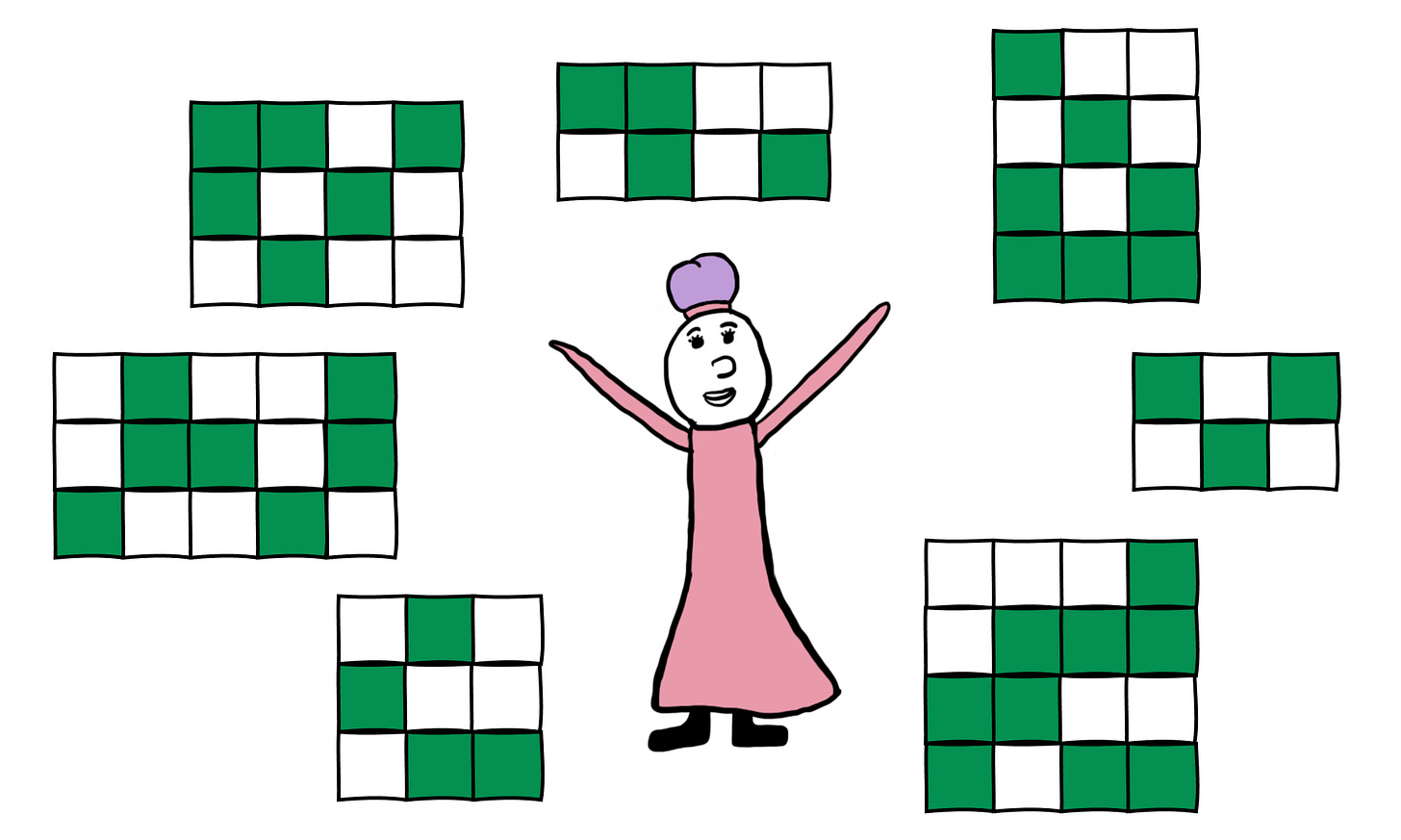Seven Puzzles
Sitting with open questions
It’s puzzle season in North America. During these dark, cold months, I’ve come to enjoy jigsaw puzzles to get off screens, do a low-stress activity with loved ones, and labor on something with no meaningful goal. A recent jigsaw I did by the aptly named Magic Puzzle Company had clever eye candy on all 1000 pieces, internal edges, and shape-shifting surprises. It was the quintessential puzzle experience, which the puzzler community illustrates as:
We start with a question (?) and arrive at a thrilling surprise (!) but spend most of our time in the arrow—the solving. This tinkering at a problem, mulling it over, and pursuing curiosity is a human desire that lures our attention.
Question, Problem, or Puzzle
An essayist once told me the kernel of any article is a question, problem, or puzzle (QPP). A QPP could be explored, dissected, or transformed through an essay, but the best QPPs are left unsolved. Any QPP worth one’s time is too meaty for a simple resolution, so we do not design an article to elicit an answer but to give the QPP a home in the reader’s mind.
Suppose an essay wants to plant an idea around integrity. We could have a question of “How do we define integrity?” or a problem like “The modern workplace makes us compromise our integrity” or a puzzle such as “How might one live with integrity in a corrupt environment?” The essay could propose solutions, but the best approach might simply plant the QPP in the reader’s mind, giving them something to ponder.
Slow-Burn Solutions
Richard Feynman—a Nobel-prize-winning physicist—claimed he was always pondering twelve questions. He kept these questions circling through his mind so that inspiration could strike from anywhere:
How can I accurately keep track of time in my head?
What is the unifying principle underlying light, radio, magnetism, and electricity?
What are the most effective ways of teaching introductory physics concepts?
Feynman took a slow-burn approach to problem-solving and attributed his most significant breakthroughs to this method. He accepted that he could not solve the most critical problems quickly or linearly, so he waited for incremental inspiration. At an elderly 28-years-old, Feynman came up with the idea for quantum electrodynamic theory while fooling around with a cafeteria tray. This spontaneous inspiration from an open question led to a fundamental shift in how we understood energy in the 20th century.
We may feel trapped when we desire a quick answer to a problem. In environments where we’re stressed about looming deadlines, urgent tasks consume us, and we may compromise quality, creativity, and curiosity to find a half-baked solution. But, if we could step back and defuse the urgency, we might reframe the trap into a puzzle.
Seven Puzzles
I didn't feel rushed when I worked on the jigsaw puzzle over Thanksgiving. I could place a few pieces, walk away to do other things, and return in a few hours to pick up where I left off. I couldn’t connect a single piece at night, but dozens fell into place the following day. While I slept, my subconscious mulled over the images and did some solving for me.
As creators, we can’t expect revelations to emerge in a silo. Inspiration will appear at random times in random places.
I don’t have as much parallel processing power as Feynman, so holding a dozen open questions seems daunting. Also, problems and questions don’t excite me the same way as puzzles, for problems are laden with negative connotations, and questions are too neutral and unsexy. But puzzles…oh my.
In the spirit of 7+/-2, we could keep seven puzzles circulating. We could hold ideas for work challenges, philosophical ponderings, relationship struggles, stories to tell, and life goals. We might keep them in a note app or small notebook—perhaps a page for each puzzle—and record related thoughts as they arise.
Over time, the puzzle pieces will snap together—in that sweet, satisfying click of completion—and our journey from the question will end in a beautiful, elegant “Aha!”
Thank you to Amy Mitchell for her generous contributions to this article. We recently collaborated on a post about slowing down to go fast with practical tips for product managers:
If you’re a PM, join me in subscribing to Amy’s Product Management IRL newsletter—where she posts weekly articles about being a PM in the real world. Amy’s posts are super relevant and actionable for this nascent profession.
Junk Drawer
Use this tool to find the cheapest version of a book.
Look at this weird unicorn skeleton in a Dutch museum.
Write with AI. OpenAI launched a free chat service to generate prose with the latest GPT-3 model. As someone who writes on the Internet, I think this is the most incredible technology I’ve seen in years.









Reframing a trap into a puzzle 🧩 - great idea!
Thank you for working together on our articles Justin!
Excellent read Thanks again.